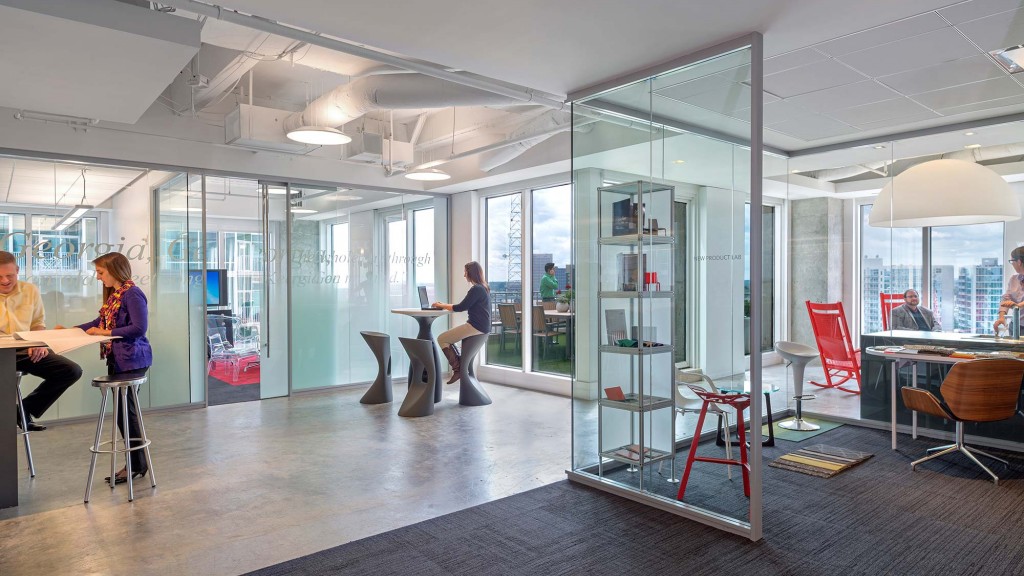Is your work environment aligned with employee behavior?
Activity Analysis
What We Did
We developed a tool and a method to conduct observational analysis related to space utilization, which we call Activity Analysis. An observer walked a predetermined route, usually 14 times per day, and recorded whether spaces were occupied, and, if so, what primary activity was occurring (such as computer work, phone calls, etc.). We collected data on handheld devices, and data management, reporting, and administration occurred on a secure website.
After reaching a critical mass of observations, we analyzed the collected data for insights that could better inform our clients on issues such as mobility (internal and external), modes of working (focus, collaboration, learning, socializing), and industry benchmarks. We use this knowledge to translate occupancy data into useful information for our clients and design teams.
The Context
Discussions around space use and occupancy are often anecdotal. Observational data collection in the workplace is reasonably widespread among industry consultants, but the methods are often antiquated and the output is in need of improvement. Objective, accurate occupancy data (as opposed to employee-reported) is an invaluable tool to understand space needs and utilization, and offers a useful complement to Gensler’s other research tools like the Workplace Performance Index (WPI), which collects self-reported data in a survey format. The amount of time employees spend at their desks is one area in which observed data and self-reported data appear to differ—employees often over-report the time spent at their desks during a given week.
The ability to record—and show the client—how often spaces are actually being used, and whether they are being used as intended, can provide valuable insight into understanding and improving a client’s space. Clients are especially interested in occupancy patterns in different space types, the right-sizing of shared support spaces (aligning room sizes with observed meeting sizes), and the levels of mobility within a building and offsite across business groups and job titles.
The Results
Our database now includes over 1 million observational data points. As we analyze the data, we have noted a number of trends that start to tell a larger story. The majority of meetings are in groups of only two to four people—often prompting us to realign the provision and mix of conference room types in the workplaces we design. Individual workstations tend to sit unoccupied more than half of the day (62% of the time), raising the possibility of increasing efficiency through either smaller or shared workstations or other mobile work solutions. When employees are at their desks, the vast majority of time is spent working on the computer—73% on average.
These findings tend to be reasonably consistent across client industries and locations—though not always. An interesting exception: We’ve noticed a decline in virtual meeting participants within the technology sector alone. This may be due to the adoption of agile work processes that promote concentrated periods of focus work during the day.
What This Means
Observation techniques can identify productivity enhancements. A quantifiable methodology for measuring and analyzing work behaviors and patterns is one of the most direct paths to improved productivity. Understanding existing behaviors is necessary to identify opportunities for improvement.
Technology is disrupting workplace behavior. Over the last 10 years, information technology use migrated from the corporate realm into consumer-focused applications and products. The rapid adoption of these technologies into our personal lives is changing how we perform many work activities.
New work processes require a different allocation of conference rooms. Distributed teams, virtual meeting technologies, and more agile work processes have dramatically changed the way we meet. As a consequence, spaces designed five or more years ago often have too many large conference rooms and not enough small ones.
Understanding internal worker mobility is essential for seat planning. In the past, “mobility” meant working away from the office. Today, worker presence at the office is being encouraged and is highly valued for many companies—but that doesn’t mean just sitting at a desk. Supporting mobility internal to the office or campus is essential to optimizing employees’ work processes and facility efficiency.
What’s Next?
There has been a recent surge of investment in sensors that track behavior and space usage, either integrated into building systems or worn by individuals. This increases the ability to collect information about work behaviors. Recently, we worked with a client to achieve a 10% reduction in the company’s asset forecast by applying insight from a probability analysis we ran on data from existing sensors. We see significant opportunities for further application with corporate, retail, and hospitality clients.
Learn More
Team
Gervais Tompkin, Andrew Garnar-Wortzel, John Duvivier, Nambi Gardner, Randy Howder, Chris Jerde
Year Completed
2011
Comments or ideas for further questions we should investigate?
